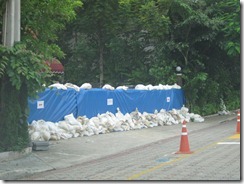December 26, 2010.
My travel day from Lusaka, Zambia to Arusha, Tanzania was rather uneventful. I did not feel fully recovered from whatever illness hit me the previous week but still well enough to attempt to summit Kilimanjaro, the tallest mountain in Africa at 5,895 meters (19,341 feet). I went with a group to four climbers from Lusaka to Arusha, one of Tanzania’s largest cities about 1.5 hours from the entrance to Kilimanjaro National Park, via Dar Es Salaam, Tanzania. The mountain is so imposing that it affects the climate of the lowlands below, causing changes in weather patterns over short distances depending on proximity of the mountain and wind currents. While the area around the rural airport is a semi-arid plain, Arusha itself is situated in an overgrown, subtropical bowl flourishing in the shadow of Kilimanjaro’s sister mountain, Mount Meru. The city itself is quite organic and gives one the impression that it grew and expanded through osmosis. Roads run willy nilly and thread through shade trees with high-rise hotels co-existing with ramshackle brick buildings housing a variety of family businesses emblazoned with bright colors and hand painted signs. A small, stereotypical taste of the flavor of Africa.
The airline offered to put us on an earlier flight to Arusha. We arrived three hours earlier than scheduled and missed our guide at the airport. We took an overpriced airport taxi to our hotel, a backpacker-style spartan accommodation called the Arusha Tourist Inn (not to be confused with its twin, the Arusha Tourist Centre Inn). The $45 hotel was fine for the outbound portion of our climb. The room was sparse but neat and none too well lit. The walls were paper thin and reverberated with the sounds of climbers and other adventurers loitering at the hotel. They were quite a vocal bunch, particularly the drunk man yelling unintelligibly in the alleyway behind the hotel at 4 a.m. in the morning.
Our guide, August, met us at our hotel to talk about the climb. We worked out logistics ranging from what to expect on the climb to whether to bunk alone to what to do or not to do to prepare for the climb. We learned ipso facto that it’s not a good idea to drink alcohol before climb as it might hasten the effects of altitude sickness – after we had consumed moderate quantities of beer. During dinner, a somewhat greasy meat-and-pasta heavy fare, we talked to two chatty Danish women who had returned earlier that day from a successful climb. Cheery and full of good spirits, they inspired us with horror stories of freezing weather and the unavoidable challenges of climbing a mountain that reaches into the upper atmosphere. They recounted how they had thwarted a robbery attempt in the main square and news of another tourist who had been injured in an attack by thieves. I made a note not to tour Arusha without a body guard.
I retired to my room about 9 p.m. and set about arranging my belongings for the climb. I had packed some valuables in my carry-on luggage and need to regroup them according to function. I set aside clothing for my first day of hiking and consolidated clothing, food, and other accessories into separate bags. My entire life for a week wrapped up in protective plastic. I missed home already.
In the faint light of the room, I wondered whether I would make it to the top of Kilimanjaro. Could I do it? After all, former tennis star Martina Navratilova had had to be evacuated from the mountain after she succumbed to altitude sickness. I wasn’t so sure I would succeed considering my nagging chest cold and frame that still carried too much weight despite rigorous training. I wondered what challenges and difficulties lay before me, praying that I would overcome them and achieve this elusive goal.
Lessons learned: Don’t drink alcohol before a climb! Do not walk around Arusha like a tourist. It’s too dangerous, and you’re too easy a target for would-be thieves.




